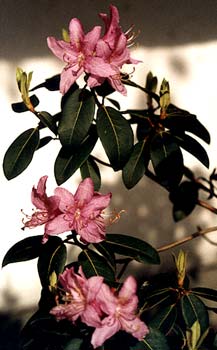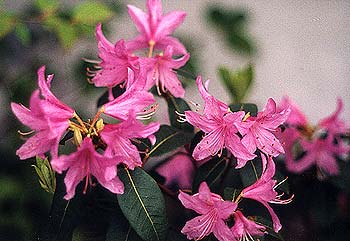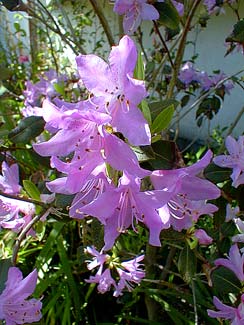 Rhododendron concinnum,
Rhododendron concinnum,
the beauty from Yunnan
"All too often we are giving young people cut flowers when
we should be teaching them to grow their own plants.
-John W. Gardner
(1912-2002)
(1912-2002)
Rhododendron concinnum has gone through many name changes, having formerly been known as R. apiculatum, R. atroviride , R. benthamianum, R. coombense, R. hutchinsonianum, R. laetevirens, R. pseudoyanthinum, R. subcoombense, & R. yanthinum. In 2002 we obtained a narrow, neck-high specimen from the Rhododendron Species Foundation, then tried to figure out where to put it after we got it home. It's always much wiser to know in advance where something is going to go, but on a once-each-spring sort of special event like the Foundation sale, sometimes the risk must be taken in just grabbing what is most thrilling, just so long as there's some certainty of being able to provide for it properly.
Most rhodies are slow-growing, but this one can put on a half-foot a year which is moderately fast growth for a rhododendron, fully mature at eight feet, & could someday be fifteen feet tall. In the Weyerhaueser Rhododendron Garden (by which the Foundation sales occur) we spotted some very large ones indeed, right at the entrance.
 So there could be no crowding ours in among dwarf azaleas & semi-dwarf rhodies. We finally selected a dappled morning-sun location near our big vine maple where it can dominate even at its present smallish size, but has space to grow large over time.
So there could be no crowding ours in among dwarf azaleas & semi-dwarf rhodies. We finally selected a dappled morning-sun location near our big vine maple where it can dominate even at its present smallish size, but has space to grow large over time.The gardening world, in focusing on the biggest-blooming hybrid rhododendrons, to some extent errs by insufficiently respecting the original species plants. They are often showy without being gawdy, with a correct balance of bright blooms & gleaming foliage, rather than excessive blooms hiding the foliage.
R. concinnum produces ample middle-sized & subtle & fragrant pale lavender-violet trumpets late April (when first photo was taken) well into May (when second photo was taken). The third photo was taken a year later (April 2003). You can view later photos of this shrub on the R. concinnum page of the Rhododendron Blooms Gallery.
 The roundish aromatic leaves are dark green on one side, grey-green on the lower side, having plenty of leaves but not so thick one cannot also appreciate the elegant upright tree-like form of the branches. It is really one of the most attractive of the species rhododendrons, in or out of bloom.
The roundish aromatic leaves are dark green on one side, grey-green on the lower side, having plenty of leaves but not so thick one cannot also appreciate the elegant upright tree-like form of the branches. It is really one of the most attractive of the species rhododendrons, in or out of bloom.The Reverand Ernest Faber spotted R. concinnum in Yunnan, China, in 1886, & introduced it to western gardening. It replaces its evergreen leaves in two year cycles & is at its twiggiest early spring but replaces the percentage of leaves that were lost toward the end of the bloom period. It is hardy in the Northwest; it might not be hardy in less temperate regions.
A couple decades after Faber, Ernest "Chinese" Wilson found R. concinnum growing on the mountains Omei & Wa-shan, which provided a calcareous limestone environment. In general such soil is not suitable to rhododendrons, which require acidic humusy soil. It would appear that gardeners not blessed with ideal soils for rhododendrons might find this species shrub adaptable to slightly alkaline conditions that would make most rhodies chloratic. Besides R. concinnum, other species which Wilson found in alkaline mountain soils were R. insigne, R. strigillosum & R. williamsianum.
An odd feature I accidentally discovered is something I will have to remember to check out for other rhodies in the future. I was removing the burst-opened star-shaped seedpods that still clung from the previous year. As I was crumbling them in my hand, I noticed these empty pods had a very cinnamony smell! I immediately looked about for other lingering pods on other rhodies. Found some on the Whitethroat Azalea, & those when crushed did not have this marvelous odor (even though its flowers are always very fragrant).
By appearance & fragrance the R. concinnum pods reminded me of a spice I cook with from time to time, whole Star Anise, though only about a third the size of a star anise pod. Except for the fact that rhodies can be mildly toxic, I would be tempted to try these opened star-pods in a soup as a substitute for star anise. It'd probably be safe with the devil cooked out of it, but am I nervy enough to risk it? Nahhh.